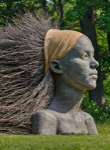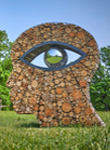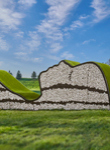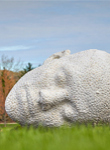The outstanding feature of Eurasian smoke tree is the large, airy, plume-like stalks that hold the small flowers. These are covered with hairs that provide the appearance of a puff of smoke. Eurasian smoke tree will grow as either a single-trunked tree or a multi-stemmed shrub. Although it may suffer from dieback in cold winters, vigorous stems bounce back to life in spring. The purple-leaved cultivars are popular as landscape accents.
Size and Form:
Eurasian smoke tree grows 10 to 15 feet high and wide with an upright to irregular habit.
Native geographic location and habitat:
This tree is native to Europe and Asia
Bark color and texture:
The bark is relatively smooth and light gray when young, but takes on a more flaky appearance with age.
Leaf or needle arrangement, size, shape, and texture:
Simple, alternate leaves, are oval or slightly elongated and grow 1 to 3 inches long. Leaf color is green on the species, but will vary by cultivar, with being red, purple, or yellow. Fall color is reddish-purple on the species, although some cultivars turn orange.
Flower arrangement, shape, and size:
The actual flowers are tiny and not showy. The structure that holds the flowers is covered with hairs and this is the actual ‘smoke’ for which the tree is named.
Fruit, cone, nut, and seed descriptions:
The true fruit are small and dry. Again, the structure that holds the fruit is the source of the ‘smoke’ of this plant.
Plant care:
This tree grows best in full sun to light shade in well-drained soil. Avoid planting in low-lying areas where soil remains wet. Shallow roots will benefit with a layer of mulch to moderate soil temperatures. Prune cultivars with colored foliage heavily to produce new growth, as the newer growth produces the best color.
List of pests, diseases, and tolerances:
Eurasian smoke trees may be affected by verticillium wilt and may suffer from dieback in cold winters.
Daydream Eurasian smoke tree (Cotinus coggygria ‘Daydream’):
This variety has bluish-green leaves that turn yellow to red in the fall. It has dense clusters of persistent flower stalks producing purplish-red ‘smoke’ in mid-summer.
Golden Spirit smoke tree (Cotinus coggygria ‘Ancot’):
Smaller than the species, this variety is oval to rounded, reaching 6 to 8 feet high and 5 to 6 feet wide. Its new foliage emerges chartreuse (gold to lime green), changes to medium green in summer. Fall color ranges from pink, orange, coral, and red.
Grace smoke tree (Cotinus ‘Grace’):
A hybrid of Cotinus obovatus and Cotinus coggygria, ‘Velvet Cloak’, this cultivar has large pink flower panicles with 4 to 6 inch long blue-green leaves. It can be a small tree or large shrub reaching 15 to 20 feet high.
Nordine smoke tree (Cotinus coggygria ‘Nordine’):
One of the hardiest of the purple-leaf forms and selected from The Morton Arboretum collections, this cultivar has oval to slightly elongated purplish-red leaves that hold color well into the summer. Fall color is an orange-yellow.
Royal Purple smoke tree (Cotinus coggygria ‘Royal Purple’):
This upright tree grows 10 to 15 feet high and 10 feet wide. It has dark purple leaves in summer and red-purple in fall. The ‘smoke’ is also reddish-purple.
Velvet Cloak smoke tree (Cotinus coggygria ‘Velvet Cloak’):
This variety has dark, oval to slightly elongated purple leaves and maintains color throughout the summer. Fall color is a reddish-purple. Large, purple-pink, airy, plume-like flower stalk clusters provide interest all summer.

























































































